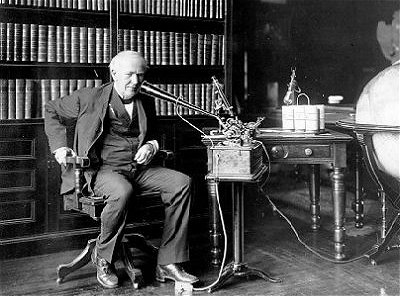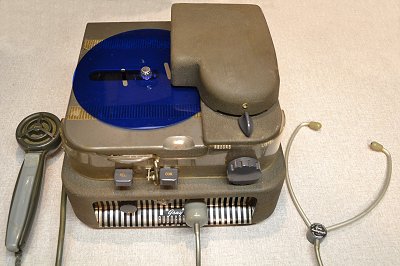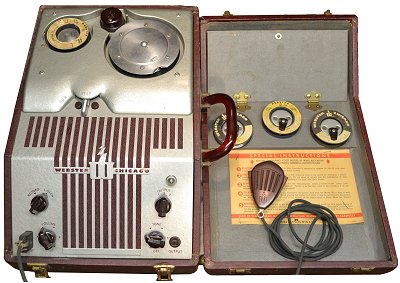BY STEVE JOHNSON ()
Through the years the recording of voice and sound has used different technologies and formats. Early dictation machines recorded on tin foil, wax cylinders, and then vinyl. Later methods used large rubber bands, wire, and magnetic tape to record and store voice and sound. By the 1990s digital storage became portable and has now rendered all earlier forms of recording and storage obsolete. Today sound, music, and video may be digitally recorded by small handheld devices and sent around the world in a few seconds.
Cylinder recorders
In the 1800s Thomas Edison invented an early mechanical recording device that would cut grooves in tin foil wrapped around a cast iron cylinder. Unfortunately the foil could only be played back a few times, was very poor audio quality, and would tear easily. Alexander Graham Bell improved on Edison's invention by cutting grooves in wax cylinders.

Thomas Edison with an early recording device.
The wax cylinder proved to be more durable than Edison's early foil-covered cylinder and could be replayed many more times. Edison's grooves were cut in a hill and dale, up and down cut while Bell's system cut the grooves side by side. This side-by-side cutting method went on to be used in most records and is still used in records manufactured today. Wax cylinders continued to be used as a recording medium in many dictating machines through World War II. Early Edison foil recorders will sell in the thousands of dollars, while later electrified Edison cylinder recorders in working condition may sometimes be found for $100 to $200.
At the end of World War II, Dictaphone, which was one of the largest manufacturers of dictating equipment, switched to a plastic belt. These belts with grooves cut into them proved to be more durable. By the late 1940s vinyl disks appeared on many dictating machines. Then in 1961 IBM released its first line of “Executary” dictating machines. IBM's new machine used a magnetic belt that could be re-recorded and edited, which had not possible with earlier plastic belts, cylinders, or disks.
Vinyl disks
In the late 1940s and throughout the 1950s several manufacturers, including Edison, produced recording equipment using flexible vinyl disks. When first released, the flexible disk had a couple of advantages over other types of recording media of the time. Flexible disks were easy to mail and more economical to manufacture, thus reducing operating costs.

The Audograph dictating machine with microphone and headphones.
One of these widely used disk-based dictation machines, which is still commonly found today, was the “Audograph,” manufactured by the Gray Manufacturing Company in Hartford, CT. Released in 1945, the Audograph recorded on a thin 7-inch vinyl disk. The Audograph could record up to 30 minutes of sound on a single disk. The operator would insert a blank disk and dictate into a handheld microphone. The disk could then be sent to another department or easily mailed to another office, where a typist could then create a letter or report by playing the disk on another Audograph while listening through headphones. Smaller than most other recorders of the time, the Audograph was considered a portable unit and was often purchased with a leather carrying case. Audographs were produced for several years and were still being used when magnetic tape began to replace vinyl media in dictation equipment. Today Audographs may be found for a little as $20, but early versions may sell for as high as $150 in good condition with all the attachments, disks, and original leather carrying case.
Wire recorders
Webster-Chicago Corp. produced a line of wire recorders that were used as dictation machines, meeting and court recorders, and finally for home use. Recording on a spool of a thin wire allowed longer-lasting recordings than thin vinyl disks provided. Many wire recorders found today have spools of original recordings that can still be played. By the 1950s wire recorders were becoming popular in the home and many found today still have playable recordings made by family members.

A Webster-Chicago model 80-1 wire recorder.
Wire recorders are popular with collectors and when found can sell for $150 to $250 in good working condition. Unfortunately, most found today need mechanical and electrical repair to bring them back to working order.
Magnetic media
Recording on magnetic media was invented in the late 1800s, but the ability to record and play back magnetic tape in high quality was not developed until World War II when Germans first used magnetic tape recorders for recording and playing radio broadcasts. In the United States, magnetic tape for high-quality recording was reportedly first used by Bing Crosby in 1947 for pre-recording his songs in the studio for later radio broadcast. The radio industry immediately embraced the magnetic recording technology that allowed them to make recordings that rivaled live broadcasts and then replay them many times without the loss of fidelity. By the 1960s tape recorders had found a place in high end home stereo systems and remained there until the 1980s when compact disks and digital music arrived on the scene.

A 7-inch vinyl disk, a spool of magnetic recording wire, and one of today's handheld digital recorders.
I find it interesting that for over a decade there were several different technologies being widely used for recording voice and sound. Throughout the 1950s, businesses were using vinyl disks and wire recorders for dictation while radio had embraced the use of magnetic tape for re-broadcasting. Eventually magnetic tape also dominated the recording market in business as well as consumer audio.
For more information and examples of early electronic technology view my collection at StevesAntiqueTechnology.com.
Advertisement





